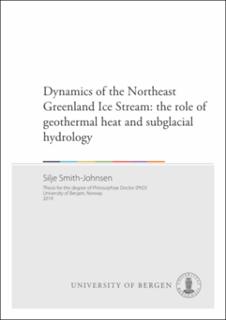| dc.contributor.author | Smith-Johnsen, Silje | |
| dc.date.accessioned | 2019-12-12T09:51:35Z | |
| dc.date.available | 2019-12-12T09:51:35Z | |
| dc.date.issued | 2019-11-15 | |
| dc.date.submitted | 2019-10-31T12:13:16.173Z | |
| dc.identifier | container/ab/bd/2e/01/abbd2e01-b6de-443b-9bce-0600983925ed | |
| dc.identifier.uri | https://hdl.handle.net/1956/21107 | |
| dc.description.abstract | Ice streams are rivers of fast flowing ice, crucial for the mass balance of ice sheets. The Greenland Ice Sheet shows a complex flow pattern, where a few major ice streams drain most of the ice sheet, contributing to sea level rise. It is therefore crucial to capture ice streams in ice flow models when predicting the future response of the Greenland Ice Sheet to a warmer climate. The Northeast Greenland Ice Stream (NEGIS) drains 12% of the ice sheet, and holds 1.1 m of sea level equivalent. It displays a unique velocity pattern with fast flow initiated close to the ice divide. This is further inland than any other ice stream in Greenland. Geothermal heat flux, the natural heat from the Earth, is thought to be the trigger of the ice stream. A local high geothermal heat flux at the head of the Northeast Greenland Ice Stream generates basal water which lubricates the ice-bed interface and induces fast flow. Models of geothermal heat flux display a large range for Greenland, and their coarse resolution is unable to capture local anomalies, as the one suggested at the onset of the Northeast Greenland Ice Stream. Previous studies investigated how geothermal heat flux influences ice dynamics, and did not find a significant impact. However, these studies focused on the direct thermal effect on ice softness, and did not include the indirect effect of water pressure. I hypothesize that, excluding the combined effect of geothermal heat flux and subglacial hydrology, accounts for the fact that the observed velocity of the Northeast Greenland Ice Stream is poorly represented in ice sheet models. This thesis investigates how geothermal heat flux influences the subglacial hydrol- ogy and the dynamics of ice streams. The goal is to understand the processes at the bed of the Northeast Greenland Ice Stream, and to improve its representation in an ice sheet model. The model used is the Ice Sheet System Model (ISSM), a state of the art fully coupled thermomechanical ice flow model. Here, for the first time, a sophisticated subglacial hydrology model is coupled to ice dynamics in ISSM. The simulations show that the choice of geothermal heat flux largely controls whether the bed of the Northeast Greenland is frozen or thawed. This sets the basal melt rates and controls the subglacial hydrology. As a consequence, the effect of geother- mal heat flux on ice flow is increased tenfold when including the coupling between subglacial hydrology and ice dynamics. In summary, local geothermal heat flux anomalies can induce fast flow. For the Northeast Greenland Ice Stream, subglacial hydrology accounts for a substantial part of the observed velocity pattern. By introducing an exceptionally high and locally contained geothermal heat flux anomaly, the ice flow model successfully reproduces the velocity pattern of the Northeast Greenland Ice Stream. | en_US |
| dc.language.iso | eng | eng |
| dc.publisher | The University of Bergen | en_US |
| dc.relation.haspart | Paper 1: Smith-Johnsen, S, de Fleurian, B., Nisancioglu, K. H., The role of subglacial hy- drology in ice streams with elevated geothermal heat flux. The article is not available in BORA. | en_US |
| dc.relation.haspart | Paper 2: Smith-Johnsen, S, Schlegel, N., de Fleurian, B., Nisancioglu, K. H., Sensitivity of the Northeast Greenland Ice Stream to Geothermal Heat. The article is not available in BORA. | en_US |
| dc.relation.haspart | Paper 3: Smith-Johnsen, S, de Fleurian, B., Schlegel, N., Seroussi, H., Nisancioglu, K. H., Exceptionally High Geothermal Heat Flux Needed to Sustain the North- east Greenland Ice Stream. The article is not available in BORA. | en_US |
| dc.rights | In copyright | eng |
| dc.rights.uri | http://rightsstatements.org/page/InC/1.0/ | eng |
| dc.title | Dynamics of the Northeast Greenland Ice Stream: the role of geothermal heat and subglacial hydrology | en_US |
| dc.type | Doctoral thesis | |
| dc.date.updated | 2019-10-31T12:13:16.173Z | |
| dc.rights.holder | Copyright the Author. All rights reserved | en_US |
| dc.identifier.cristin | 1745897 | |
| fs.unitcode | 12-50-0 | |
